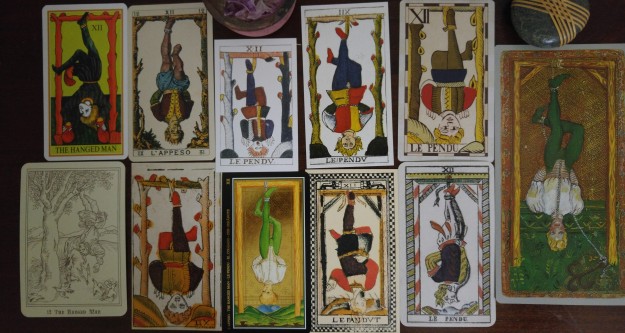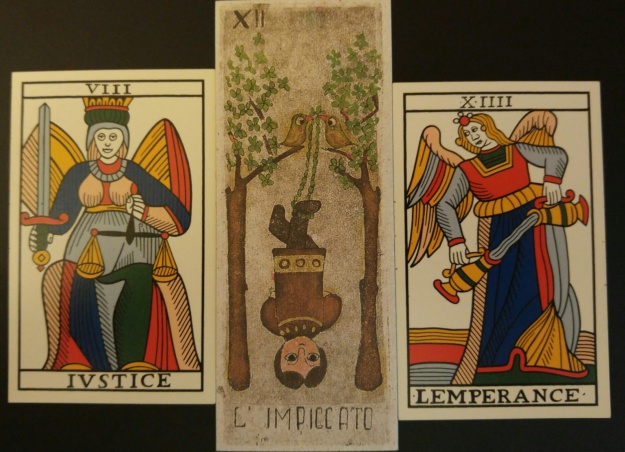
If you are looking to read Tarot cards by actually seeing them, rather than by an overlay of imposed or associative meanings, you could find no finer card to practice on than the Hanged Man, Le Pendu. Like many of us, I have no cultural reference for this card to get in my way and trip me up. In my country we’ve had plenty of hangings (and that sadly nuanced, more modern version, the lynching), but the participants were always right side up. Hung from a gallows, or a single tree. A rope around the neck making the impending outcome quite clear.
But this strange card! A frame made of living, albeit stripped, trees rising from their mounds of earth, from which suspends an upside-down figure of inscrutable expression, bound only by an ankle–what to make of it? It’s much more equivocal; we don’t quite see where it leads. I have to let myself be Le Pendu for a while, to get a sense of him. Blood rushing to my head, arms useless, gravity pulling my ankle against its rope. Could I get out of this? With much better abs than I personally possess, could someone raise himself upright and extricate himself? How long can Le Pendu hang suspended? After all, it’s trump 12, followed by the Unnamed One–i.e., Death himself, with a scythe to cut our friend down at the last. Perhaps from noting this sequence, we can infer that no one is playing a brief unpleasant joke on a friend, or conducting a fraternity initiation, or imposing on himself a short, painful test of will.
The Hanged Man is caught in something that’s partly man-made (rope, a cross-bar) and partly natural (living trees). He’s been framed–literally. He sits between Strength and Death in the chain of trumps. In the Noblet Tarot de Marseilles, his broken fingers look like nascent wings.
Okay, some back-story. Don’t worry, this won’t give you a quick answer. You’ll still have to read the card yourself, because no one seems to know the historical motivation for this image. Or rather, there are lots of different theories. Perhaps the most compelling arguments are made for our man being a traitor. Pittura infamante–“shame paintings,” with the shamed subject in this position–were common in parts of Italy during Tarot’s formative years. So while I may not have a cultural reference in my North American unconscious, my Italian friends do. Even in modern times, the bodies of Mussolini and his female companion were hanged upside down. (Oddly, the proceedings were momentarily halted to find something to tie around the lady’s skirt, to keep everything covered properly once she was upside-down. This strange courtesy was probably more for the moral benefit of the onlookers than in deference to the modest feelings of the corpse itself.) Other theorists in the “traitor” camp associate the image with Christianity’s ultimate traitor, Judas. Indeed, in some early decks the figure is portrayed with bags of money in his hands, rather than with folded arms.
Others trace the posture to that of martyrdom, particularly that of St. Gregory of Armenia. He was martyred in this position, and his skull apparently resided in Italy for centuries, providing familiarity and inspiration for Italian card makers. The card’s never been called “The Martyr,” though, only Traitor or Hanged Man. (Interestingly, St. Peter, who requested to be crucified upside-down, was both a martyr and a traitor, if one recalls his thrice-repudiation of Jesus “before the cock crows.”) Still other theories point to some pre-Christian initiatory practices that include this posture. The look on the Hanged Man’s face is oddly peaceful, even in many early decks, which lends support to the idea of our friend hanging voluntarily, at least after he’s been stuck there. Not all acquiesce so gracefully, though–the Noblet’s Pendu sticks out his tongue, his hair flies wildly about his head, and his fingers rise so oddly from his shoulders that I’m reminded that Italian traitors had their arms broken before their inverted hanging.
Given the historical confusion, the image may have been created with one meaning and then been taken over by another, maybe even multiple times. So much for history giving us the real scoop.
People say the Hanged Man card means surrender, or renunciation, or initiation. The more I ponder this image, the less I know what it means. The only thing I’m pretty sure of is that Le Pendu is helpless, caught. He has no agency. Whether he surrenders to this circumstance, finds God or nirvana–who knows? He’s like Bill Murray in the movie “Groundhog Day.” It didn’t start out as a spiritual experience, waking up to Sonny and Cher singing “I Got You Babe” and living the exact same day over and over for eternity. But once you are irrevocably caught, and you’ve tried every other attitude from bravado to despair, then there’s nothing left to try but acceptance and service. So maybe we are seeing our man once he’s been hanging long enough to give up and take the long view.
I don’t know what this hanging fellow means. The surrounding cards do, of course, in any spread where he shows up. You could say that about any card, if you are reading by observation rather than by definitions. In the spirit of my teacher Camelia Elias, Enrique Enriquez, and others, that is the way of reading that interests me. But whereas I imagine I know what an Emperor or a Pope is, luckily for me the Hanged Man is an enigma. So I can’t fall so easily into mental habits. I have to find out for myself, each time he appears, what he’s doing there. In the end, the medium is the message. I am the Hanged Man–without context, without help, just me and my humble inner resources–every time he turns up (errr, upside-down).
I confess my current obsession with this card was ignited by an unusual Hanged Man–that of the modern Marseille-type deck, La Corte dei Tarocchi. This is a deck filled with visual texture–beautifully patterned robes and chain mail on the court cards, interesting arrangements on the pip cards–and lovely muted colors. The figures are probably too ingenuous for a lot of people, though. Il Diavolo–the Devil–looks like a winged monkey from the Wizard of Oz. La Morte waves his scythe like a kid whipping a streamer, and the Fool resembles the young, waif-like Audrey Hepburn more than a crazed tramp.
I’m pretty much done with deciding how cards “ought” to look (Bacchus appearing in the Vandenborre Tarot–read about it here–seemed to have cured me of that). If I’m just reading cards, then I’m just reading cards, period. But this deck’s Hanged Man! I just about had a relapse, plunging me into wonderful confusion. L’impiccato–the Hanged–is a toddler whose rope is a chain of leaves or braided grass, held up by two birds. (Quirky factoid: top hits from googling “l’impiccato,” as I did to double-check my understanding of the Italian, are images of the word-game Hangman.) The green chain isn’t even tied around his ankle, so though he has the traditional posture of bent leg and arms behind back, it’s pretty clear he could be on his feet in an instant. He looks lots happier than the two children in Il Sole, whose dismayed expressions are that of two little girls shocked at the antics of a “bad” boy, possibly this L’impiccato himself. Like the boy who climbs to the very top of the monkey bars when teacher’s back is turned, he wears a tiny Mona Lisa smile.
Given that I find this deck, with its thick cardstock and toothy texture, to be almost impossible to shuffle, I’ve spent more time looking at the cards than throwing them. I haven’t yet had L’impiccato appear in a reading. But I’d just had Le Pendu come up in a reading with the Noblet Tarot de Marseille, so I had an idea. What if I swapped Le Pendu for this Hanged Kid? How would that change what I saw?
The question: What do I need to give to the course I’m about to take? (originally read using Jean Noblet Tarot)
Justice–The Hanged Man–Temperance

The original interpretation: You need to surrender your current level of clear-eyed, yet static truth, in order to open to a more flowing level of skill.
Now: Same question, same spread, but substituting L’impiccato for Le Pendu:

The new version: I see the principal ready to mete out justice, but the school cook is keeping an eye on the naughty child while she washes up. So: Keep a low profile and you’ll get help from unexpected places. Don’t kick the teacher. (Looks like the child is about to give Justice the boot.)
And reading the question and the answer with all three cards from La Corte dei Tarocchi?

You are a dreamy beginner in the midst of some heavy-duty academic types. Are you sure you want to take this course and become like them?
So I think L’impiccato will do just fine, if he will let himself be shuffled.
Oh, and the title of this blog post? I love those fanciful English collective nouns for animals–a murder of crows, a clutter of cats. What expression might suit my collection of Hanged Men, pictured at the start of this post? After reviewing a compendium of nouns here I settled on the noun for turtle doves–a piteousness of doves. Maybe our hanged sinners are saints after all.
Note: I’m not a Tarot historian, just an internet reveler. Some sources that fueled my thoughts are here, here, here and here.
Cards:
“Group photo” Row 1 L to R: Dame Fortune’s Wheel (Paul Huson); Soprafino (Lo Scarabeo Ancient Italian Tarot edition); Noblet (Peterson restoration, 2016); Madenie (1st ed. reproduced by Yves Renaud); Vandenborre (Game of Hope reproduction, 2016); Row 2 L to R: Ship of Fools Tarot (Williams, based on 16th c. woodcuts from the book Ship of Fools); Vieville (Sivilixi reproduction); Visconti Tarot (Lo Scarabeo restoration); Tarot de Paris (Andre Dimanche/Grimaud reproduction); Gassman c. 1810 (Game of Hope reproduction); Side card: Cary-Yale Visconti Tarocchi (US Games ed).
Tarot de Jean Noblet (Flornoy restoration)
La Corte Dei Tarocchi (D’Onofrio/Il Meneghello)
Blog contents © 2016 by the author.

Linking themes of Hangman and Groundhog Day is brilliant, great illustration !
LikeLiked by 1 person
Thanks! That movie is very profound really.
LikeLiked by 1 person
Thank you for your delightful post on the hanged man card. It’s the card that’s always spoken to me deeply. What a find — this L’impiccato! A really different view.
LikeLiked by 1 person
Thanks, Eva Luba! I’ve become rather fond of the little imp(iccato).
LikeLike
It’s certainly a departure for Huginn and Muninn, sweet though !
LikeLike
Had to look this up to get the allusion–thanks Gneiss! Ha!
LikeLiked by 1 person
Norse, of course ! Ha !
Welcome
LikeLike
Wonderful article. Solid history and great lesson in reading with no preconceptions.
LikeLiked by 1 person